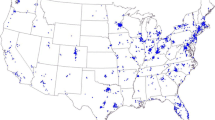Abstract
The choice of marketing system used to allocate property rights is important across many industries. In Scotland, two systems of marketing real property co-exist: fixed price, where homes are listed for sale at a fixed price on “first-come-first-serve” basis, and offers over, which is a sealed-bid auction format where the seller indicates a floor for bids. Using 4,780 detached housing sales between 1984 and 2002, this paper explores potential price effects of the seller’s choice of marketing system. Specifically, a log price model is estimated based on transactions under both marketing systems acknowledging endogeneity in the choice of marketing system. The empirical procedure reveals that sellers select the marketing system which results in the highest predicted price for their property.
Similar content being viewed by others
Notes
The four basic types of auctions analyzed in this literature are English, Dutch, first-price sealed bid, and second-price sealed-bid.
Auctions are common in housing markets in Australia, Holland, and Scotland.
English auction is a standard means used to facilitate the transfer of real property in Australia.
All interested buyers are informed when the closing date is set if they have placed a “note of interest” with the selling solicitor.
A seller may adopt to use the “fixed price” system at the start of the marketing process or switch to the “fixed price” system during the marketing process. While of interest, the data does not allow identification of sellers which switched between marketing systems during the selling process and only reveals the final marketing choice outcome.
As with the offer over system, the seller is not legally bound to sell, even if the list price is met (e.g. if unacceptable conditions are attached to the offer).
This is not the case in the Australian housing market where, as noted by Lusht (1996), commissions and advertising costs differ across the systems.
In the current study, a variable measuring the prevalence of the fixed price marketing system (CON) within a fixed distance of any given house is used to identify the selection equation and is excluded from the price equation given we would not expect the choice of marketing system to impose a price externality on other nearby homes after controlling for house characteristics and market conditions.
Accuracy of the estimated variables depend upon the variance of δ contained in the error term of Eq. 4.5.
Equation 4.8 is estimated using the methods of Maddala (1983) and Wooldridge (2010). Coefficient estimates are virtually identical between the two methods and standard errors obtained using 1,000 bootstrap for each method are equally similar (i.e. the collection of variables which are significant at 5 % level are identical for the two methods).
The ASPC is operated by a group of local solicitors and estate agents within the City of Aberdeen and Aberdeenshire.
While it would be of interest to extend the study period, sellers are required, starting in 2008, to provide prospective buyers with a home report which includes a surveyor assessment of value which may mitigate the potential for a price difference between the two marketing systems but remains a question to be answered by future research.
A property’s geo-coordinates are defined by the centroid of the postal code to which it belongs. According to 2012 National Records of Scotland GIS postcode extract data, each postal code area is physically no larger than 1 square mile.
The sample has been reduced as not to include observation where the price per bedroom is less than £7,500 or greater than £125,000. In both cases, these appear to be outliers.
Propensity score matching is used to ensure the main results are robust to concerns regarding imbalance (see Robustness Check section).
In unreported results, the sample is trimmed to remove offers over sales which occurred at discount relative to list price and fixed price sales which occurred at a premium relative to list price. The results are robust to these sample restrictions.
The variable ceases to be significant at the 5 % level when a search radius of 1.25 miles is used which seems logical as this technique is akin to an appraiser’s attempt to minimize search distance when finding sale comps when estimating a subject property’s value.
While the study has framed marketing choice as being selected by the seller, it may also be the case that the seller is merely acting in accordance with the market standard in that a property’s location and neighborhood characteristics determine the choice of system. In any case, the current study is ambivalent as to the origin of the selection choice and is primarily concerned with controlling for the selection choice bias in the price equation. In unreported results, a 3SLS model is used to account for cross-equation correlation in the error terms and the results are unchanged.
Fixed effects for 1994–2001 are insignificant relative to the omitted year of 2002.
A distance threshold (0.50mi, 0.75mi and 1mi for models 1, 2 and 3 in Table 2) is used to control for property location and the sale date difference for the matched properties is required to be less than 68 days to control for time.
As studies of propensity score matching have shown Cochran and Rubin (1973), Rosenbaum and Rubin (1983), and Austin (2011), a smaller caliper radius may reduce bias may also reduce the sample size so that the researcher must find a radius which minimizes bias and imbalance but also does not produce a prohibitively small matched sample.
In addition to standard difference in means tests, the standardized mean difference for all variables and variance ratios are checked to confirm all covariates are balanced.
References
Adams, P.D., Kluger, B.D., & Wyatt, S.B. (1992). Integrating auction and search markets: The slow dutch auction. Journal of Real Estate Finance and Economics, 5(3), 239–253.
Austin, P.C. (2011). Optimal caliper widths for propensity-score matching when estimating differences in means and differences in proportions in observational studies. Pharmaceutical Statistics, 10(2), 150–161.
Chinloy, P., Hardin, I.I.I.W., & Wu, Z. (2016). Foreclosure, reo, and market sales in residential real estate. The Journal of Real Estate Finance and Economics, 1–28.
Chow, Y.L., Hafalir, I.E., & Yavas, A. (2015). Auction versus negotiated sale: Evidence from real estate sales. Real Estate Economics, 43(2), 432–470.
Cochran, W.G., & Rubin, D.B. (1973). Controlling bias in observational studies: A review. Sankhyā:The Indian Journal of Statistics. Series A, 35(4), 417–446.
Gan, Q. (2013). Optimal selling mechanism, auction discounts and time on market. Real Estate Economics, 41(2), 347–383.
Goldfeld, S.M., & Quandt, R.E. (1972). Nonlinear Methods in Econometrics. Amsterdam: North Holland Publishing Co.
Goldfeld, S.M., & Quandt, R.E. (1973). The estimation of structural shifts by switching regressions. Annals of Economic and Social Measurement, 4(2), 475–485.
Han, L., & Strange, W.C. (2014). Bidding wars for houses. Real Estate Economics, 42(1), 1–32.
Hansen, R.G. (1986). Sealed-bid versus open auctions: The evidence. Economic Inquiry, 24(1), 125–142.
Heckman, J.J. (1976a). The common structure of statistical models of truncation, sample selection and limited dependent variables and a simple estimator for such models. Annals of Economic and Social Measurement, 5(4), 475–492.
Heckman, J.J. (1976b). Simultaneous equations models with continuous and discrete endogenous variables and structural shifts. In Goldfeld, S.M., & Quandt, R.E. (Eds.), Studies in Nonlinear Estimation (pp. 235–275). Cambridge: Ballinger.
Heckman, J.J., & Robb, R. (1985a). Alternative methods for evaluating the impact of interventions. Journal of Econometrics, 30(1), 239–267.
Heckman, J.J., & Robb, R.J. (1985b). Alternative methods for evaluating the impact of interventions. In Heckman, J.J., & Singer, B.S. (Eds.), Longitudinal Analysis of Labor Market Data (pp. 156–246): Cambridge University Press.
Lee, L.F. (1982). Some approaches to the correction of selectivity bias. The Review of Economic Studies, 49(3), 355–372.
Lee, L.F., Maddala, G.S., & Trost, R.P. (1979). Testing for structural change by d-methods in switching simultaneous equation models, American Statistical Association Proceedings of Economic and Business Section.
Lusht, K.M. (1996). A comparison of prices brought by english auctions and private negotiations. Real Estate Economics, 24(4), 517–530.
Maddala, G.S. (1983). Limited-dependent and qualitative variables in econometrics. Cambridge: Cambridge University Press.
Mayer, C.J. (1995). A model of negotiated sales applied to real estate auctions. Journal of Urban Economics, 38(1), 1–22.
Mayer, C.J. (1998). Assessing the performance of real estate auctions. Real Estate Economics, 26(1), 41–66.
McAfee, R.P., & McMillan, J. (1987). Auctions and bidding. Journal of Economic Literature, 25(2), 699–738.
McMillen, D.P., & McDonald, J.F. (1989). Selectivity bias in urban land value functions. Land Economics, 65(4), 341–351.
McMillen, D.P., & McDonald, J.F. (1991). Urban land value functions with endogenous zoning. Journal of Urban Economics, 29(1), 14–27.
Ooi, J.T., Sirmans, C., & Turnbull, G.K. (2006). Price formation under small numbers competition: Evidence from land auctions in singapore. Real Estate Economics, 34(1), 51–76.
Quan, D.C. (1994). Real estate auctions: A survey of theory and practice. The Journal of Real Estate Finance and Economics, 9(1), 23–49.
Quan, D.C. (2002). Market mechanism choice and real estate disposition: Search versus auction. Real Estate Economics, 30(3), 365–384.
Rosenbaum, P.R., & Rubin, D.B. (1983). The central role of the propensity score in observational studies for causal effects. Biometrika, 70(1), 41–55.
Tse, M.K.S., Pretorius, F.I.H., & Chau, K.W. (2011). Market sentiments, winner’s curse and bidding outcome in land auctions. Journal of Real Estate Finance and Economics, 42(3), 247–274.
Vickrey, W. (1961). Counterspeculation, auctions, and competitive sealed tenders. The Journal of finance, 16(1), 8–37.
Wallace, N.E. (1988). The market effects of zoning undeveloped land: Does zoning follow the market Journal of Urban Economics, 23(3), 307–326.
Wang, R. (1993). Auctions versus posted-price selling. American Economic Review, 83(4), 838–851.
Wooldridge, J.M. (2010). Econometric Analysis of Cross Section and Panel Data, 2nd edn. Cambridge, MA: MIT Press.
Acknowledgments
We appreciate the constructive feedback of anonymous reviewers as well as seminar participants at the American Real Estate and Urban Economics Association annual meeting and European Real Estate Society conference. We mourn our departed friend and college, Carolyn Dehring, who was actively involved in this project. We hope this paper reflects her love and passion for research.
Author information
Authors and Affiliations
Corresponding author
Additional information
Carolyn Dehring: Deceased 11 March 2015
Rights and permissions
About this article
Cite this article
Buschbom, S., Dehring, C., Dunse, N. et al. Sealed-Bid Auctions and Fixed Price Sales: Seller Choice in Housing Markets. J Real Estate Finan Econ 56, 525–545 (2018). https://doi.org/10.1007/s11146-017-9603-6
Published:
Issue Date:
DOI: https://doi.org/10.1007/s11146-017-9603-6




